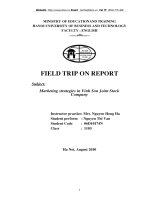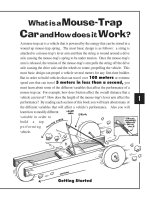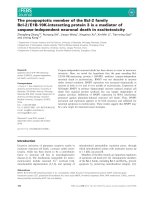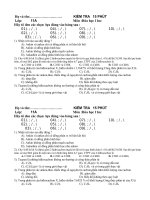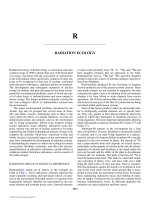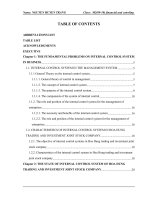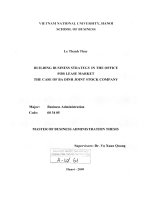Topic 01 IT in organisation
Bạn đang xem bản rút gọn của tài liệu. Xem và tải ngay bản đầy đủ của tài liệu tại đây (344.44 KB, 31 trang )
Topic 01
IT IN ORGANISATION
BMIT5103 Course
Information Technology for Managers
Dr. Huy Nguyen
BMIT5103
John von Neumann Institute - Vietnam National
University
Ho Chi Minh
City
Information
Technology
for Managers
BMIT5103
STUDY GUIDE
TOPIC 01
“IT in Organisation”
• Learning outcomes:
1. Describe the characteristics of the digital economy and e-business;
2. Explain the pressures in the business environment, and the critical
response activities that organisations take to counter the pressures;
3. Discuss the developments and trends of IT;
4. Describe major categories of systems that support business
transaction processing, and various groups of people and their tasks;
5. Describe how IT supports of Supply Chains and Enterprise Systems.
Information Technology for Managers
2
BMIT5103
STUDY GUIDE
TOPIC 01
“IT in Organisation”
• Introduction:
- How business processes and activities have been fundamentally altered
with the advent of the digital economy;
- How IT has changed the ways that businesses compete from traditional
to digital environment;
- How IT becomes a major facilitator in organisations and changes how,
why and where businesses do, people work and live;
- Why organisations are moving to the digital economy and how the
strategic uses of IT are in this new economy;
- How IT supports people and organisational activities;
- Main types of IT support systems and how these systems have
developed to include strategic responses to changes in the environment
and strategic innovation systems;
- Managerial issues on IT in organisation.
Information Technology for Managers
3
BMIT5103
AGENDA
• Strategic Use of IT in the Digital Economy
• IT Support Systems
• Managerial Issues
Information Technology for Managers
4
BMIT5103
AGENDA
• Strategic Use of IT in the Digital Economy
• IT Support Systems
• Managerial Issues
Information Technology for Managers
5
BMIT5103
STRATEGIC VIEW OF IT IN THE DIGITAL ECONOMY
• Overview of Emerging Digital Economy
• Business Pressures, Organisational Performances and IT Support
• Information Technology Developments and Trends
Information Technology for Managers
6
BMIT5103
STRATEGIC VIEW OF IT IN THE DIGITAL ECONOMY
OVERVIEW OF EMERGING DIGITAL ECONOMY
• Digital economy means the organisation is involved in:
- Electronic Business (E-Business): Use of electronic technologies to
transact business;
- Collaboration: Interacting, communicating, collaborating and searching
for information of people and organisations;
- Information Exchange: Storing, processing and transmission of data
and information that can be processed and transmitted through the
Internet to many destinations worldwide.
Information Technology for Managers
7
BMIT5103
STRATEGIC VIEW OF IT IN THE DIGITAL ECONOMY
OVERVIEW OF EMERGING DIGITAL ECONOMY
• Business model:
- Method of doing business by which a company can generate revenue to
sustain itself;
- Four popular business models in the digital economy:
• Tendering via Reverse Auctions: Reverse form of auctioning takes place
where the lowest bid wins;
• Affiliate Marketing: Website becomes a host site to other businesses;
• Group Purchasing: Purchase orders of many buyers are aggregated in order
to negotiate for discounts, small and medium size businesses or even
individuals can participate in such models;
• E-marketplaces and Exchanges: Involve trading between buyers and sellers
in an electronic marketplace (e-marketplace) that is a virtual marketplace
where transactions are conducted virtually.
Information Technology for Managers
8
BMIT5103
STRATEGIC VIEW OF IT IN THE DIGITAL ECONOMY
BUSINESS PRESSURES, ORGANISATIONAL
PERFORMANCES & IT SUPPORT
• Business pressures:
- Significant and sometimes unpredictable changes in the social,
technological, legal, economic, physical and political factors are likely to
create business pressures on organisations;
- Major business pressures:
• Economic/market: Global economy and strong competition, the need for
real time operations, the changing workforce and powerful customers;
• Technology: Technological innovations, obsolescence and information
overload;
• Society: Social responsibility, compliance with government regulations and
deregulations, ethical issues, terrorist attacks and homeland security.
Information Technology for Managers
9
BMIT5103
STRATEGIC VIEW OF IT IN THE DIGITAL ECONOMY
BUSINESS PRESSURES, ORGANISATIONAL
PERFORMANCES & IT SUPPORT
• Organisation’s major responses to reduce the impact of threats and
increase the impact of opportunities:
- Strategic management and systems: Enable organisations to
increase market share and/or profits;
- Continuous improvement: Increase their operational efficiency;
- Restructuring business processes: Fundamentally and radically
redesign its business processes to archive dramatic improvements;
- Manufacturer to order: Produce products and services on demand;
- Mass-customization: Customised orders are fulfilled using efficient
procedures and processes;
- Customer focus strategy: Provide superb customer service, anticipate
their future needs, respond to their concerns, and prevent losing them to
competitors;
Information Technology for Managers
10
BMIT5103
STRATEGIC VIEW OF IT IN THE DIGITAL ECONOMY
BUSINESS PRESSURES, ORGANISATIONAL
PERFORMANCES & IT SUPPORT
• Organisation’s major responses (cont.):
- E-commerce: Process of buying, selling, transferring, or exchanging
products, services, and/or information via computer networks, including
the Internet;
- E-business: Broader definition of e-commerce, not just the buying and
selling of goods and services, but also servicing customers,
collaborating with business partners, conducting e-learning, and
processing electronic transactions;
- Business alliances: Many companies have alliances and business
linkageswith other companies for effective collaboration to reduce risks
and costs;
- Data management: Data are foundation of any information system and
need to be managed throughout their life cycle, which converts data to
useful information, knowledge, and a basis for decision support.
Information Technology for Managers
11
BMIT5103
STRATEGIC VIEW OF IT IN THE DIGITAL ECONOMY
INFORMATION TECHNOLOGY DEVELOPMENTS & TRENDS
General
Cost decrease, performance increase;
enormous increases in computer
processing capacity and sharp decline in
cost
Storage capacity will increase dramatically
Multimedia use increase especially virtual
reality
Computers will be increasingly compact
and more portable
Push for open architecture, e.g. open
source
Networked computing
Storage network; many corporations are
relying on outside server to manage their
technology, which they can access via the
web
Mobile and wireless computing will be a
major component of IT
Optical computing will increase network
capacity; these high capacity
telecommunication networks will convert
signals to colours of light and transmit
these over fiber optical filement
Intelligent systems such as expert system
are embedded in other system
The used Internet will grow
E-commerce changing businesses
Plug-and-play software increase; softwareas-a-service
Networked and intelligent systems
Information Technology for Managers
RFID (Radio Frequency Identification)
12
BMIT5103
AGENDA
• Strategic Use of IT in the Digital Economy
• IT Support Systems
• Managerial Issues
Information Technology for Managers
13
BMIT5103
AGENDA
• Strategic Use of IT in the Digital Economy
• IT Support Systems
• Managerial Issues
Information Technology for Managers
14
BMIT5103
IT SUPPORT SYSTEMS
• Information System and Information Technology
• Categories of Support System
• IT Supports of Supply Chains and Enterprise Systems
Information Technology for Managers
15
BMIT5103
IT SUPPORT SYSTEMS
INFORMATION SYSTEM & INFORMATION TECHNOLOGY
• Information systems:
- Basic functions:
• Collect, process, store, analyse, and disseminate information for specific
purposes;
- Basic components:
• Hardware: Variety of physical devices such as processors, monitor,
keyboard, and mouse;
• Software: Set of programs that instruct the hardware to process data;
• Database: Place where data is stored;
• Network: Communication channel that permits sharing of resources;
• Procedures: Set of instructions or rules for the computer to follow in order to
produce a desired output;
• People: All individuals that are related to the system.
Information Technology for Managers
16
BMIT5103
IT SUPPORT SYSTEMS
INFORMATION SYSTEM & INFORMATION TECHNOLOGY
• Systematic view of an information system:
Information Technology for Managers
17
BMIT5103
IT SUPPORT SYSTEMS
CATEGORIES OF SUPPORT SYSTEM
•
Transaction Processing System (TPS)
•
Office Automation System (OAS)
•
Management Information System (MIS)
•
Knowledge Management System (KMS)
•
Decision Support System (DSS)
•
Intelligent Support System (ISS)
•
Executive Support System (ESS)
Information Technology for Managers
18
BMIT5103
IT SUPPORT SYSTEMS
CATEGORIES OF SUPPORT SYSTEM
• Transaction Processing System (TPS):
- Operating support systems that record and process data resulting from
business transactions;
- Automate routine and repetitive tasks that are critical to the operation of
the organization, process thousands of transactions daily;
- Transactions include sales, payments, inventory, hiring and firing,
paying employees and many others, and will be processed in two basic
ways:
• Batch processing: Transaction data are accumulated over a period of time
and processed periodically;
• Real-time processing: Transaction data are processed immediately after
the transaction occurs.
- Data or information from this operation could also be the input data for
many applications involving support systems such as MIS and DSS.
Information Technology for Managers
19
BMIT5103
IT SUPPORT SYSTEMS
CATEGORIES OF SUPPORT SYSTEM
• Office Automation System (OAS):
- Set of office-related systems used to increase the productivity of office
workers and enable workers to interact and work together more
efficiently.
• Management Information System (MIS):
- Access, organise, summarise, and display information in supporting
routine decision making in the functional areas;
- Geared toward middle managers, MIS are characterized mainly by their
ability to produce periodic reports such as a daily list of employees and
the hours they work, or a monthly report of expenses as compared to a
budget.
Information Technology for Managers
20
BMIT5103
IT SUPPORT SYSTEMS
CATEGORIES OF SUPPORT SYSTEM
• Knowledge Management System (KMS):
- Knowledge-based information systems that support the creation,
organisation and dissemation of business knowledge to employees and
managers throughout a company;
- Enable individuals and organisations to enhance learning, improve
performance and, hopefully, produce long term sustainable competitive
advantage;
- Facilitate the sharing and transferring of knowledge and enhances
learning.
• Decision Support System (DSS):
- Computer-based system designed to assist a manager or decision
maker in making decisions;
- Incorporate both data and models to help a decision maker or tactical
level management in solving a problem that is less structured;
- Input data are often extracted from TPS or a data warehouse.
Information Technology for Managers
21
BMIT5103
IT SUPPORT SYSTEMS
CATEGORIES OF SUPPORT SYSTEM
• Intelligence Support System (ISS):
- Apply artificial intelligence (AI) techniques to business information
systems;
- Expert system (ES) provides the stored knowledge of experts to
nonexperts, so that the latter can solve difficult or time-consuming
problems in the absence of the expert;
- Difference from TPS, which centre on data, and from MIS and DSS,
which concentrated on processing information and users make their
decisions according to the information generated from the systems, ES
makes recommended decisions for the users based on the built-in
expertise and knowledge.
Information Technology for Managers
22
BMIT5103
IT SUPPORT SYSTEMS
CATEGORIES OF SUPPORT SYSTEM
• Executive Support System (ESS):
- Executive Information System (EIS);
- Combine many features of MIS and DSS, focus on meeting strategic
information needs of top management and is widely used by managers,
analyst and other knowledge workers with more features been added to
the system;
- Give top executives an easy way to get the critical information they
wanted, when they wanted it, and tailored to the formats they preferred;
- Ability to drill down, which allows executives to retrieve quickly displays
of related information at lower levels of detail.
Information Technology for Managers
23
BMIT5103
IT SUPPORT SYSTEMS
CATEGORIES OF SUPPORT SYSTEM
• Classification of information systems by support functions:
Information Technology for Managers
24
BMIT5103
IT SUPPORT SYSTEMS
IT SUPPORTS OF SUPPLY CHAINS & ENTERPRISE SYSTEMS
• Supply chain:
- Flow of materials, information, funds, and services from raw material
suppliers through factories and warehouses to the end customers;
- Main parts:
• Upstream supply chain: Organisations first-tier suppliers and their
suppliers;
• Internal supply chain: All the processes used by an organisation in
transforming the inputs of the suppliers to outputs;
• Downstream supply chain: All the processes involved in delivering the
products to final customers.
- Support from IT:
• Upstream supply chain: Improving the procurement activities;
• Internal supply chain: Building effective internal data exchange and
communication;
• Downstream supply chain: Supporting Customer Relationship
Management (CRM), and order taking and shipments to customers.
Information Technology for Managers
25
